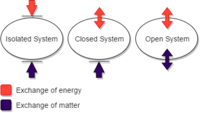
Photo from wikipedia
Abstract The simplified Clausius-Clapeyron equation with the assumption of a constant molar enthalpy of vaporization is not adequate for general applications, despite the desirable need of using only two experimental… Click to show full abstract
Abstract The simplified Clausius-Clapeyron equation with the assumption of a constant molar enthalpy of vaporization is not adequate for general applications, despite the desirable need of using only two experimental values for the two integration constants. Therefore many correlations and models of equations of state with more than two necessary empirical constants are used. Here the critical state equation is used as a starting point, with a power sequence as a mathematical model for the estimation of the critical constants for small molecules and for homologous series. With the n-alkanes as reference class for all organic compounds, a reference vapor pressure equation has been defined as function of the relative molecular mass M, which represents principally the correct temperature dependence over the entire liquid state of n-alkanes. With an additional, temperature dependent structural increment U, with the same dimensionless unit as M, a generally applicable vapor pressure equation results for all organic fluids which needs only two specific experimental values. In this investigation principally liquids with freezing point, Tf Most remarkably, for the application of the developed equation only a small number of easily available empirical parameters are needed as structure increments U and fractions δ of U. The qualitative relation of these parameters to the polarities and other properties of the investigated compounds allow a better understanding of the main reasons for the relative magnitude of vapor pressures and their interactions in mixtures.
Journal Title: Fluid Phase Equilibria
Year Published: 2020
Link to full text (if available)
Share on Social Media: Sign Up to like & get
recommendations!